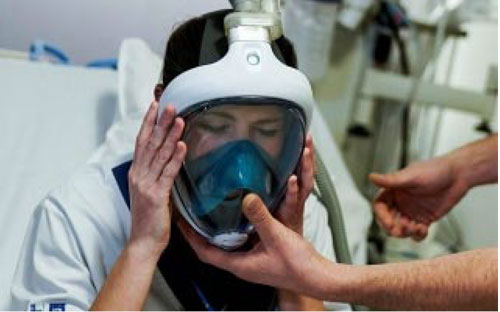BRUSSELS As hospitals face an overload of COVID-19 patients struggling to breathe, innovative medical staff are turning to snorkel masks from sports stores to stop their lungs from collapsing. The idea started in Italy, the European country worst-hit by the coronavirus pandemic, with hospitals in other nations taking note and adding their own specific medical parts to make it work. One such is the Erasme Hospital on the outskirts of Belgium’s capital Brussels. It is attached to the city’s ULB university — and through it to a private spin-off, Endo Tools Therapeutics, whose knowhow in 3D printing for medical use has proved invaluable. “They are to be used for patients with severe respiratory problems. The aim is to avoid having to intubate the trachea of the patient and putthem on a respirator,” said FredericBonnier, a respiratory physiotherapist atthe hospital who also teaches at the university. He spearheaded the design of a custommade valve that fits to the top of full-face masks, where the snorkel is meant to go, allowing them to connect to standard BiPAP machines that feed pressurised air into masks. This helps prevent the collapse of alveoli, lung air sacs needed for the intake of oxygen into our bodies and the exhalation of carbon dioxide. Pneumonia brought on by COVID19 inflames the lung membrane and fills those sacs with liquid. In the worst-case infections, patients have to be hooked up to respirators in intensivecare units. But respirators are in desperately short supply worldwide because of the sheer number of patients. The snorkelling mask solution could be a stop-gap measure for patients on the brink of intensive-care treatment but for whom no beds nor respirators are available. Hospital masks for the less-intensive BiPAP (bilevel positive airway pressure) machines are also lacking. Bonnier said that from Monday he will testing 50 of the masks on patients. They are the same brand as those used by Italian doctors, donated by the French sportswear retailer Decathlon that has stores worldwide. The masks themselves are made in Italy. He explained they were far more comfortable than the hospital ones that fit over the nose and mouth, biting into the skin. But he cautioned they were not tested to medical standards, meaning they were one-use only, unable to be sterilised between patients. The Italian design for the 3D-printed valve also needed reworking. “It seemed fairly complicated to make, pretty heavy, not very comfortable. So we had the idea to go a little further by thinking on it and developing our own connection part,” he said. The new plastic valve connectors have now been 3D-printed and are ready to be tested. Bonnier added that health workers in COVID-19 wards could also use the masks for protection against the virus. But he fears the public will start panic-buying them, thereby depriving hospitals of a potentially life-saving product.—AFP










